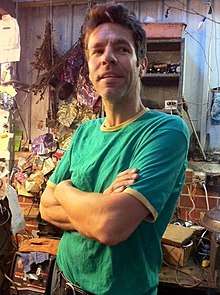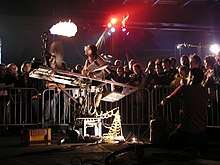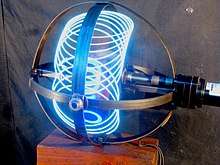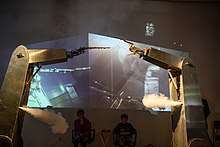Kal Spelletich
Kal Spelletich (/ˈspɛlətɪtʃ/ SPELL-ə-titch[1]) is an American contemporary artist. A pioneer of San Francisco's machine art scene, he hand builds complex machines and robots. Current work, in 2018, includes building functional artificial robotic organs as a residence of the Stochastic Labs in Berkeley California. Through a collaboration with audience members who volunteer to control or operate his sculptures, Spelletich's work explores the interface of robots and humans. Early work frequently incorporated fire and "extremely dangerous" situations, to examine the boundaries of fear, control and exhilaration. By the late 1990s Spelletich started incorporating sensors in his sculptures to engage with questions about technology, spirituality, and play.[2][3][4]
Kal Spelletich | |
|---|---|
 | |
| Born | Kalman Spelletich 1960 |
| Nationality | American |
| Alma mater | University of Iowa University of Texas, Austin |
| Known for | Machine art |
| Movement | San Francisco Machine Art |



Early life and education
Spelletich grew up in Davenport, Iowa, where his parents owned a construction company. The seventh of nine children, he was given a chemistry set at nine, and began to experiment with fire and alchemy. At 18, he joined the International Harvester tractor assembly line and as a member of the United Auto Workers Union, he was exposed to mass production and large scale building processes.[5][6]
Spelletich attended the University of Iowa. He studied photography and graduated with a BFA in interdisciplinary art. He earned an MFA from the University of Texas, Austin. He helped to start the Austin Media Arts Center after he received his master's degree.
Career
Spelletich is considered a pioneer of San Francisco's machine-art scene.[7] Spelletich builds interactive robots and brain machine interfaces using technology currently at the forefront of scientific research for medical, militaristic or consumer applications.[8]
Spelletich explores emotional boundaries related to risk and play.[9] His work is interactive, requiring participants to enter or operate the piece, often against their instincts of self-preservation.[10] The collaboration with the audience completes the work.[11] His work often includes elements of fear, play, humor and absurdity[3][12] such as a hugging machine,[13] robots that grab and lift the participants in the air, harvest and respond to bio data and praying robots.[14]
Brain machine interface work began in 2016 and includes Split Brain Robotics (collaboration with Mitch Altman ) which incorporates a hacked EEG as a neural interface and a computer to analyze the data and signal the robots responses.[15][16]
In September, 2016, Amazon Video greenlit a pilot Budding Prospects that is based on the life of Kal Spelletich in the 1980s.
Early work
In 1989 Spelletich founded the interactive machine art performance collective Seemen (stylized SEEMEN) — in the 1991 Richard Linklater film Slacker, Spelletich played a character who wore a backpack of television sets, similar to the TV backpacks the Seemen wore in their "often-jarring" performances.[17] He was involved in Austin's music scene, and collaborated with bands including the Butthole Surfers and Scratch Acid. In August 1999, Spin wrote that Spelletich's work was influenced by American punk rock and informed by his "homegrown mechanical expertise" and his "art school exposure to Dadaists and Duchamp."[4][18][6][17][19] With Seemen, he constructed "notorious" installations at the Burning Man festival such as the three headed hound Cerebus, an animated fire spewing sculpture made of metal.[20][21]
In 2001, Spelletich began to build pieces that incorporated biofeedback sensors. The Levitator lifted a volunteer based on a device that measured respiration; another piece used breath analysis to connect a turbine jet engine with an afterburner. The installation The EKG Ring monitored volunteers sitting in the center of a ring of fire, with the fire pulsing in time with their heartbeats. In 2006, he constructed "Monkey on Your Back", a backpack robot with multiple arms and EKG sensors that responded to changes in a participant's heart rate.[22][21]
Further reading
- Boas, Natasha. (2015) “Poetic Kinetics or Intentional Imperfection,” SFAQ, March 26.[23]
- Kino, Carol. (2014) “Artists on Artists: Chris Johanson on the Apocalyptic Machines of Kal Spelletich,” T: The New York Times Style Magazine, August 16.[24]
References
- "Kal Spelletich, artist in San Francisco #FREEDOM". Retrieved 23 June 2020.
- Smith, Matt. "Seemen's Kal Spelletich Takes Fire-Shooting Robot Art to Prague". SF Weekly. Retrieved 2018-01-14.
- "Art in Review". The New York Times. 14 August 2009. Retrieved 26 November 2017.
- Lee, Henry (August 1, 1999). Killer Apps. Spin.
- "Kal Spelletich: In Conversation With Chris Cobb". SFAQ / NYAQ / LXAQ. Retrieved 2018-01-20.
- "Kal Spelletich". KQED Spark. Retrieved 2018-01-13.
- Kino, Carol (23 October 2014). "Jules Maeght Unveils 'Art in Motion'". Retrieved 26 November 2017 – via www.nytimes.com.
- "Promise of Play PBS Documentary". Vimeo. Retrieved 26 November 2017.
- "Fear and Fun: Performing the Human-Machine Interface - Events - Berkeley Center for New Media". bcnm.berkeley.edu. Retrieved 26 November 2017.
- "Interactive Robots by Kal Spelletich". famsf.org. 28 October 2013. Retrieved 26 November 2017.
- "UC Berkeley Art, Technology, and Culture Colloquium - Bio: Kal Spelletich". atc.berkeley.edu. Retrieved 26 November 2017.
- "Kal Spelletich's art: Where man meets machine". dailyrepublic.com. 28 July 2013. Retrieved 26 November 2017.
- "Hugging robot / Boing Boing". boingboing.net. Retrieved 26 November 2017.
- "Kal Spelletich - Works - Catharine Clark Gallery". cclarkgallery.com. Retrieved 26 November 2017.
- "It takes brains to make robots perform as art". sfgate.com. Retrieved 26 November 2017.
- ""Mindreading" robots and tech-art insanity in San Francisco this Friday-Sunday / Boing Boing". boingboing.net. Retrieved 26 November 2017.
- "Why one provocative artist built 'praying robots' for his newest installation". Retrieved 2018-01-13.
- Leo., Nash, A. (2007). Burning man : art in the desert. New York: Abrams. ISBN 9780810992900. OCLC 76967217.
- "Kal Spelletich's mystical robots intended to help the world". SFGate. Retrieved 2018-01-13.
- "The Early Years | Burning Man". burningman.org. Retrieved 2018-01-20.
- "the art section". the art section. Retrieved 2018-01-18.
- "Fire Arts of Burning Man". www.leonardo.info. Retrieved 2018-01-20.
- "Poetic Kinetics or Intentional Imperfection". sfaq.us. Retrieved 26 November 2017.
- Kino, Carol. "Artists on Artists - Chris Johanson on the Apocalyptic Machines of Kal Spelletich". nytimes.com. Retrieved 26 November 2017.